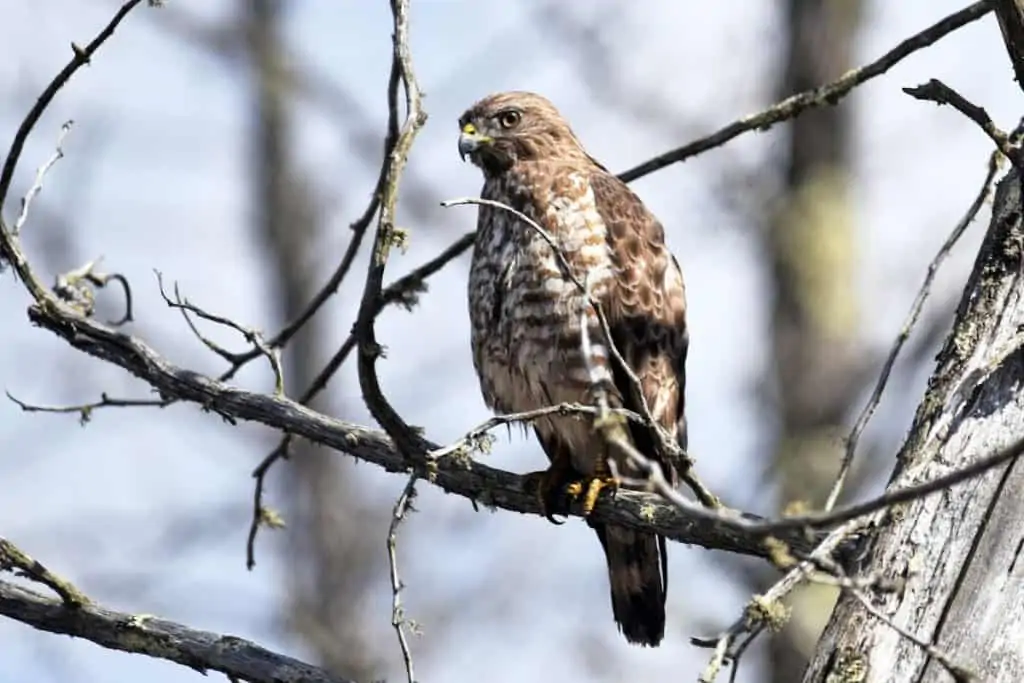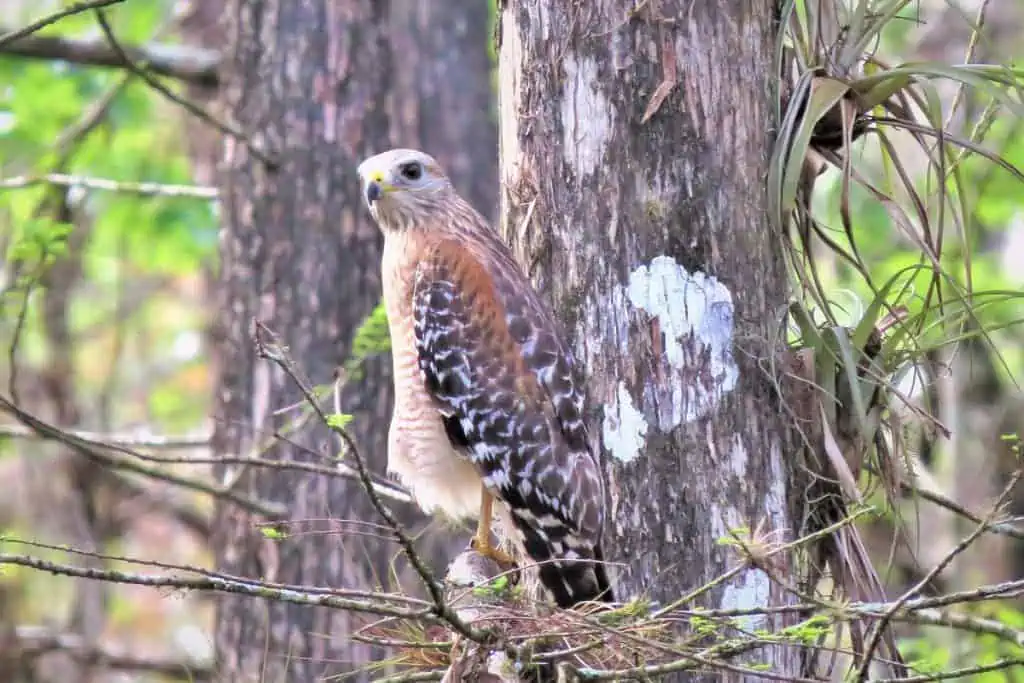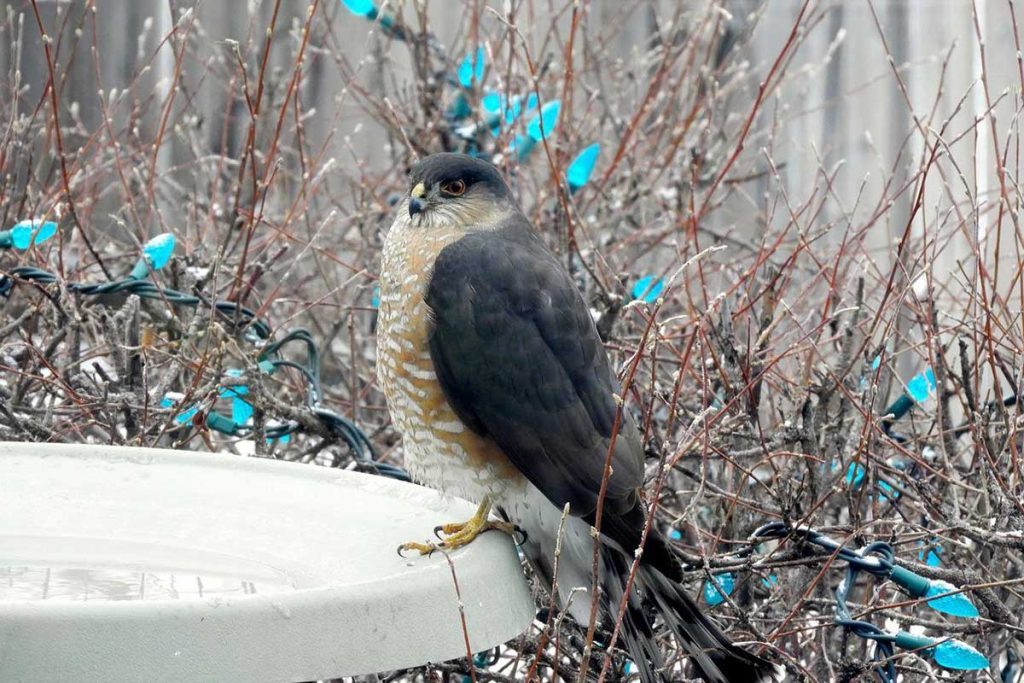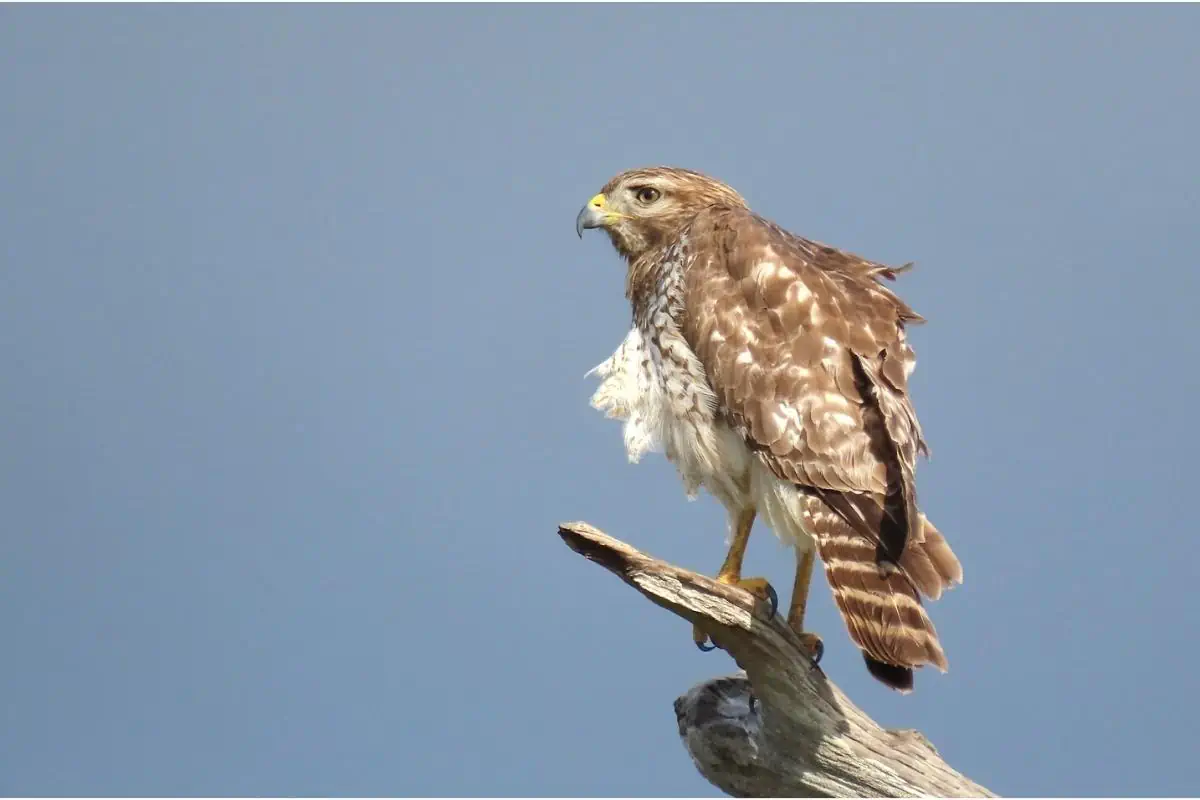The hawks are tremendous predators. Their acute hearing and vision, as well as their razor-sharp beak and talons, all come together to make them superb birds of prey. Humans have benefited from hawks’ hunting skills throughout history, using training and falconry. Hawks live in the United States in about 16 different species. Yet, we’ll be looking at the eight kinds of hawks found in Rhode Island in this piece.
HAWKS IN RHODE ISLAND
The broad-winged hawk, Coopers hawk, northern goshawk, northern harrier, red-tailed hawk, red-shouldered hawk, rough-legged hawk, and sharp-shinnedhawk are the eight species of hawks that may be found in Rhode Island.
Let’s take a look at each one.
1. BROAD-WINGED HAWK

Scientific name: Buteo platypterus
Length: 13.4-17.3 in
Weight: 9.3-19.8 oz
Wingspan: 31.9-39.4 in
Only during the spring-summer breeding season do broad-winged hawks migrate north into Rhode Island. The head and chest of these smaller hawks are brown, and the underparts are barred. The tail is black and white. Their small tail and wide wings with pointed ends are visible in flight.
During the breeding season, these hawks prefer to be alone. They’ll build nests in remote areas, such as forests and lakes. Little animals, such as mice and insects, as well as amphibians like frogs and toads.
Your best bet is to watch them on their way back South America during fall migration if you want to see the broad-winged hawk. Flocks of birds called “kettles” soar through the air, each with hundreds of others. You may see them in woodlands if you are not on their migration path. Pay attention to their shrill whistles.
2. COOPERS HAWK

Scientific name: Accipiter cooperii
Length: 14.6 – 17.7 in
Weight: 7.8 – 24.0 oz
Wingspan: 24.4-35.4 in
Cooper’s hawks can be found all year round in Rhode Island, and they can be found across most of North America. Adults have a red eye and a squared-off head with a black hat. They have a blue-gray back with heavy orange barring on the chest. The eye of immature birds is yellow, the back and head are brown, and the underparts are white with strong brown streaks.
They seem to be quite comfortable in the suburbs, as well as woods and forests. Little birds are their primary food source, which they catch with ease in the tree canopy. The Cooper’s hawk is a popular visitor in backyards, where it has been observed swooping after birds at bird feeders, particularly starlings, doves, and pigeons.
During a high-speed pursuit of birds, crashing through trees and foliage takes a toll, as did Cooper’s hawk skeletons, which revealed that many of them had previously suffered chest fractures.
3. NORTHERN GOSHAWK

Scientific name: Accipiter gentilis
Length: 20.9-25.2 in
Weight: 22.3-48.1 oz
Wingspan: 40.5-46.1 in
Goshawks have a thick stripe over each eye and a gray back with gray barring on the chest that extends all the way down the belly. They’re bigger and more vicious cousins of the sharp-shinned and cooper’s hawks. Goshawks, on the other hand, are quite stealthy and prefer to stay in the forest rather than human inhabited places.
The northern goshawk is most common throughout the autumn and winter in Rhode Island. However, since they prefer to nest in old-growth forest with deep canopy, it will be difficult for you to locate one. They’ve been known to attack humans that get too close to their nests. During the breeding season, keep an eye out for these raptors.
Little hawks, birds, creatures, reptiles, and even carrion are among the foods of the northern goshawk. Their population is difficult to estimate due to their secretive nature, and they are considered uncommon.
4. NORTHERN HARRIER

Scientific name: Circus hudsonius
Length: 18.1-19.7 in
Weight: 10.6-26.5 oz
Wingspan: 40.2-46.5 in
The face of the northern harrier is almost owl-like. This disc-shaped head, which looks like an owl, directs sound towards its ears, allowing it to hunt by sound and sight. The long tail and a white patch above the tail are two helpful identifying features. They have a unique flying technique, with their wings forming a “V.” These birds are described as “majestic” by many people.
Throughout the breeding season, and in certain sections of the year, you may see this hawk in Rhode Island. Over marshes, fields, and other wide-open areas, they’re likely to be seen.
This hawk creates a platform in dense vegetation, such as reeds, willows, sedges, and cattails, unlike many other hawks that nest in trees. Males may have two (sometimes more) partners at the same time, and they will provide for the female and offspring.
5. RED-TAILED HAWK

Scientific name: Buteo jamaicensis
Length: 17.7 – 25.6 in
Weight: 24.3oz – 51.5 oz
Wingspan: 44.9-52.4 in
The most generally seen hawk on the North American continent, red-tailed hawks can be found in practically every state, including Rhode Island, throughout the year. As birds that have spent their summer in Canada come down to join the others in the United States, their population increases even more during the winter.
Red-tailed hawks are most active in the day and early morning, and they may be seen soaring or perched along the road on telephone poles, looking for prey with their exceptional vision. Mice, rats, rabbits, and squirrels are the main sources of food for them. Birds and snakes are among the animals they may consume.
The tail of an adult is brick-red, but as a juvenile, it is brown and white striped. It is simple to identify. These hawks have a light brown underbelly and a dark brown topbelly. Their breasts are streaked with brown, and another distinguishing characteristic is the belt of darker brown streaks that runs across their belly region. Because of the variety of colors across the country, these hawks are so common.
The red-tailed hawk’s scream has become a symbol for all raptors, and it is a long one. Their cry is nearly normally utilized as the noise for any hawk or eagle seen on film in films and television.
6.RED-SHOULDERED HAWK

Scientific name: Buteo lineatus
Length: 16.9-24.0 in
Weight: 17.1-27.3 oz
Wingspan: 37.0-43.7
The range of red-shouldered hawks extends from east to west throughout the United States. California’s western shore, as well as the They are year-round residents in Rhode Island.
The thick red coloring on the breast, which extends all the way down their belly with crimson barring, is a reliable identifying characteristic. Their back and wings are covered in dark, nearly black feathers. This will be blended with reddish feathers at the summit of their backs and “shoulders.” A lot of white barring will be mixed in with the dark feathers, and the tail will be heavily banded, beginning from the midback down.
These birds prefer flooded areas and wetlands, where they live and hunt in the forest. In addition, they may be found in wooded areas intermingled with buildings in the suburbs. Although they are frequently mistaken with red-tailed hawks, once you know the distinguishing features, it’s simple to tell them apart.
7. ROUGH-LEGGED HAWK

Scientific name: Buteo lagopus
Length: 18.5-20.5 in
Weight: 25.2-49.4 oz
Wingspan: 52.0-54.3 in
Throughout the autumn and winter, rough-legged hawks may be observed in Rhode Island. They go all the way to the northern Arctic when it comes time to migrate to their breeding grounds! On cliffs and rocky outcroppings, they will nest.
They perch on poles and fence posts throughout the winter in wide-open regions of the country. Mice, voles, and shrews are hunted here. While they are less common in the state than other species, the southern coast is a good place to look for them. To get a hover-in-place perspective from which to survey the ground beneath them for their prey, rough-legged hawks are known to flap their wings and turn into the wind.
They perch on poles and fence posts in the winter, and you can find them in wide-open spaces in the states. Mice, voles, and shrews are among the animals they hunt. They are less common in the state than other species, but their southern coast is a good place to look for them. Rough-legged hawks are known to flap their wings in order to create a hover-in-placevantage point from which they may examine the earth beneath them for prey.
The feathers on rough-legged hawks’ legs give them their name. Feathers cover the full length of the legs of just a few American raptors. The majority of them have a thick black belly patch and are heavily mottled dark brown and white. As the wrist is against a light backdrop, you may spot a black patch in the air. A dark-morph that looks two-toned from below and appears nearly black is also available.
8. SHARP-SHINNED HAWK

Scientific name: Accipiter striatus
Length: 9.4-13.4 in
Weight: 3.1-7.7 oz
Wingspan: 16.9-22.1 in
The smallest hawk in the United States, sharp-shinned hawks live year-round in Rhode Island. Little birds and rodents are prey for these hawks, who pursue them in the forest.
Since they cling to woodlands with thick canopies while nesting, finding them is difficult. They’ll go to somebody’s back yard to hunt birds at feeders on occasion. During autumn migration, however, is when you’ll find them. They head south towards the United States. They are seen in large numbers at hawk watch sites from their summer range in Canada.
On their cream-colored chests and dark tail, sharp-shinned hawks have a blue-gray back with reddish-orange barring. They have a more rounded head and squared-off tail than the cooper’s hawk, which makes them look very similar.
